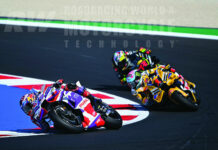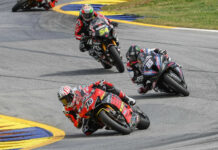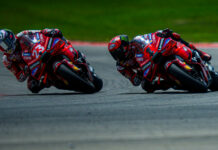From a press release issued by Dr. Rob Tuluie:
Tul-aris Smooths Powerband and Reaches 160 Rear Wheel HP Benchmark
Manley Cycle, Minneapolis, MN. The Tul-aris racing motorcycle reached the 160 rear wheel hp mark for the first time during extensive dyno testing on Doug Lofgren’s Dynojet dyno at Manley Cycle, Minneapolis. This equates to 181 hp at the crank. Furthermore, many part-throttle and full-throttle runs resulted in the smoothest powerband yet and corrected some of the powerband issues that the new 800cc motor presented during a recent magazine test at Willow Springs, California. We varied Powervalve opening rpm, increasing it back to our normal setpoint of 6800 rpm instead of the incorrect setpoint of 5700 rpm that was used during our testing at Willow Springs.
Red: Power and torque as used at Willow Springs, Dec 02
Blue: Power and torque Feb 03. Note elimination of the power drop at 6200 rpm and smoothing of power increase at 7300 rpm. Power band is now a straight line from 5700 rpm to 8200 rpm. This setup was achieved using a new ignition system and slightly shorter exhaust pipes. This particular setup produces 3 hp less than the highest result we achieved this weekend, but in return offers the smoothest powerband.
Furthermore, we varied part-throttle and full-throttle ignition timing, which is now possible thanks to the latest Polaris ignition system, which allows ignition mapping as a function of rpm, throttle position and an external input (such as gear position). We increased timing just before 7300 rpm and decreased timing just after that, in order to further smooth a step in the powerband at that rpm. Finally, a slight shortening of the exhaust pipes, suggested by Hot Seat Performance’s Steve Houle, resulted in increased rpm and power and the smoothest powerband yet. Our best figures for the day were 160.7 hp at 8200 rpm and 104.6 ft-lbs of torque, with a powerband that is an almost perfect straight line from 5700 to 8300 rpm.
An example of how things can go wrong: part throttle power with the powervalve opening set at the wrong setpoint of 5700 rpm (red). Doing nothing but changing the powervalve opening back to 6800 rpm (blue), which is what we used for most of 2002, immediately improves matters substantially.
The Tul-aris project is sponsored by: Michelin Tires, Nutec Racing Fuel, Hot Seat Performance, Ohlins USA, Lofgren Racing/Manley Cycle, Mason Racing Tires, MTS Systems Corporation, Yoyodyne Titanium, GP Tech, Carbon Fiber Specialties Products, DCM Services, Deus Ex Machina.
Tul-Aris Gets New Powerband, And More Power, Too
Tul-Aris Gets New Powerband, And More Power, Too
© 2003, Roadracing World Publishing, Inc.






